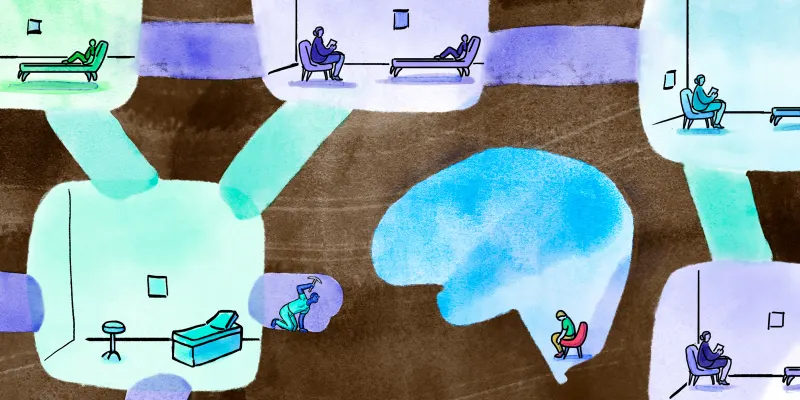
I remember the first time I met him. Remnants of a scruffy beard patterned his chin. He had a hearty laugh and occasional grin.
“I’m gonna get through this,” Mr. P* would say, again and again. He nodded to the thick cast on his leg, and the swelling. His eyes looked tired, but his mind seemed hopeful.
It was autumn, and the leaves were falling, and the white coat on my back felt alien to me. I thought to myself, I’m only a medical student, a first-year who doesn’t even know how to log into the EHR. I pressed my stethoscope to his chest, listening to the beat of his heart, and then to his back, hearing his lungs. Breathe in, breathe out.
Up to that point, I had never experienced a long-term relationship with a patient. I thought this was the only encounter I would have with Mr. P. It wasn’t.
From September to May, every few weeks I would meet Mr. P during my first-year doctoring experience, a preclinical program at the Alpert Medical School (AMS) where each student is assigned to a physician community mentor. Throughout the year, students go to these clinic sites, observe doctor-patient interactions, and practice their nascent clinical skills.
My site was an Infectious Disease clinic, where my attending sees a wide range of patients — from those with Hepatitis to Lyme disease to even Zika.
I remember my first day at the clinic — I had no idea where to go, or what to do, or what my role was. Sometimes I felt like an unnecessary body in the room, filling up space, getting in the physician’s way as he was trying to do a physical examination. The first few times I took a patient’s history, I felt like apologizing whenever the patient had to answer my long list of questions. Over time, though, I came to embrace the mantra of ‘see one, do one.’ I picked up the rhythm of my clinic site, eventually knew the nurses by name, and (finally) learned how to log onto the computer and type into the EHR.
Perhaps most significantly, my physician-mentor taught me the importance of continuity of care. Many of his patients have HIV and came to him a few times a year. Many of his other patients had an infectious disease condition that required multiple visits throughout the treatment course.
Such was the case with Mr. P. Ever since his first visit, he came into the clinic each month for follow-up, the thick cast still on his leg but the infection slowly waning. He shared elements of his family life and asked me about my own hopes and goals, always greeting me by name.
This was my first time forming a long-term relationship with a patient. I was fortunate enough that my attending scheduled Mr. P’s visits during the days I would be coming to the clinic. I was given the responsibility of typing out the case notes in the EHR, and calling Mr. P every now and then to check up on him. During a phone call, I was able to help him navigate buying the necessary prescriptions from his pharmacy. Other times, we discussed ways of staying active despite the cast, such as walking the dog. These phone calls, and the in-person times that I did see Mr. P, reinforced the importance of building relationships with patients.
The longitudinal experience is critical, especially in the first year of medical school. Even at an early stage of our medical career, the exposure to continuous clinical work sheds light on the value of simply being present for our patients. Dr. Paul George, Assistant Dean for Medical Education at AMS, emphasizes how it gives students an intimate look at individuals’ experiences. “The complexities can be eye-opening,” he explains. The longitudinal experience benefits patients, too. “These individuals may not understand how the health system works, what their disease process is or medical terminology,” says Dr. George. As patients walk through a complex and overwhelming system, medical students can fill in gaps and help advocate for them.
It is also important for all students, not just primary care-oriented students, to learn about continuity of care in their first year of medical school. Dr. George would love to see all students have a longitudinal patient relationship in the preclinical years. The future of medical education, he predicts, will see this become more common in medical schools. Whether students go into primary care or surgery, ophthalmology or endocrinology or infectious disease, as physicians they will have continuity of care with patients over days, months, years, or even decades. Moreover, not only will future physicians be providing medical care, but will also need to address the non-medical care that individuals need. “This is why it is important that first-year students receive education in this area,” says Dr. George. Only then can we start viewing patients more holistically and break down silos between disciplines and settings.
I hope more medical schools will develop and integrate a longitudinal patient program — some exist within the clinical third-year, but we need more for first-year students. My own experience taught me the importance of nurturing relationships with patients over time. It taught me the value of presence and comprehensive care. It taught me that, even in the very beginning of medical school, we can start learning, practicing, and being the kind of doctor we hope to become in the future.
Early exposure to real patients like Mr. P is vital to the first-year medical student’s education. A longitudinal patient experience reinforces the value of continuity of care and long-term interaction with patients within the context of their families and communities. And it reminds me why I came to medical school in the first place.
*Patient’s name changed for confidentiality.
Anna Delamerced is a current 3rd-year medical student at the Warren Alpert Medical School of Brown University. She was born and raised in Cincinnati, Ohio and enjoys exploring the crossroads of writing and medicine, and listening to patients tell their stories.







